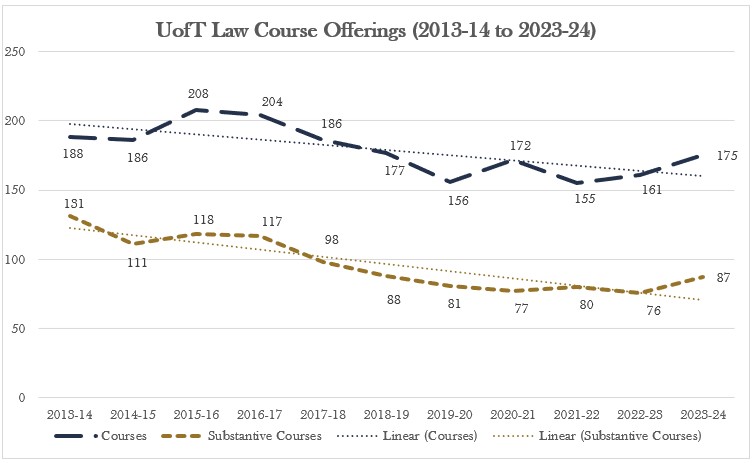Seemingly few options in course selections despite improvements
Limited course offerings were a common complaint from students and Students’ Law Society (SLS) representatives last academic year, and the data supports their complaints. 2022-2023 had the third fewest number of courses offered and the lowest number of substantive courses on record.
Introduction
The 2024-2025 U of T Law JD admissions guide boasts that JD students can “choose from over 180 courses that span the spectrum of legal practice and scholarship.” But it doesn’t feel like that.
Rather than contribute to the descent into a post-truth world, I decided to put facts over feelings and crunch the numbers.
Last year, Naomi Chernos (JD ‘23) found that in 2022-2023, U of T Law offered 161 “courses” (credit options) but only 76 of those were actually “substantive courses” (a stereotypical law course).
Methodology
The number of courses offered is taken from the annual Course Curriculum Reports (CCRs) each year for consistency. No CCR was published for 2020-2021 due to COVID-19, so I used the Course List on the U of T Law website as of November 26, 2020, instead.
For the purpose of my analysis, a “course” is defined as any credit option. A “substantive course” is a course that is not a clinic, not an externship, not a moot, and not a journal; is more than one credit; is open to “pure JD students” (JD students not doing a dual degree); and has class hours. If a course has more than one section, only the first section would potentially count as a substantive course.
All substantive courses are courses, but not all courses are substantive courses.
Results
According to the 2023-2024 CCR, there are 175 courses (i.e. 175 options) to get credits. However, 10 of those are clinics, 15 are externships, and 20 are moots. All of these are practical and valuable ways to learn, but they’re not courses in the traditional sense. Also, students can only complete one moot per year.
There are three journals, 10 intensive courses, and two externship seminars. None of these are substantive courses. The externship seminar is a one-credit mandatory co-requisite and is really just a part of doing an externship.
Then we have eight courses in the CCR that pure JD students cannot take because they are restricted to LLM students or JD/MSW students. There are five courses for directed research projects, but choosing to do independent research is more like opting out of a course than choosing a traditional course.
Lasty, there are multiple sections of some courses. You cannot take the same course more than once (assuming you pass the first time). So, any section of a course after the first one is not a substantive course even if the first section is.
The chart below shows the number of courses and substantive courses for 2013-2014 to 2023-2024 following Chernos’ methodology. I used Chernos’ data and then found, cleaned, and added the data for 2020-21 and 2023-24.

Limited course offerings were a common complaint from students and Students’ Law Society (SLS) representatives last academic year, and the data supports their complaints. 2022-2023 had the third fewest number of courses offered and the lowest number of substantive courses on record.
The number of courses and substantive courses rebounded in 2023-2024 compared to 2022-2023.
The number of courses and substantive courses peaked at 208 and 118, respectively, in 2015-16. However, the trendlines show that the number of courses and the number of substantive courses are trending downwards at a rate of 3.8 courses and 5.2 substantive courses per academic year on average.
Discussion
First, U of T Law’s claim that students can choose from over 180 courses is potentially misleading. Based on this dataset, U of T Law has never offered 180 substantive courses and has not offered over 180 courses since 2017-18.
To be charitable, sometimes courses listed in the CCR are not actually offered or courses not listed in the CCR are offered. For example, at the time of writing, there is one more substantive course and 14 more courses available for 2023-2024 than indicated in the 2023-2024 CCR, bringing the total courses offered to 189.
Associate Dean Chris Essert said:
[T]o the extent that there were more courses in the past, that’s primarily a function of our moving a number of adjunct-taught courses from being offered every year and having enrolment numbers that were significantly below the capacity of the course to being offered every second year and having enrolment numbers that are more in line with the course capacity. (So we believe that, for the most part, people who want to take these courses still get the chance to do so.)
Currently, U of T Law has about 25 courses that are offered every other year.
Second, the declining trend of substantive courses is steeper than the declining trend of courses, meaning some substantive courses are being replaced with non-substantive courses. This may indicate that U of T Law is becoming more practical and “hands-on,” and less academic.
Third, when it comes to courses, more than quantity matters. All the upper-year JD students I spoke to were happy with the 2023-24 winter course offerings. Most were disappointed in the 2023-24 fall course offerings and were struggling to fill their schedules with offerings that interested them or supported their career goals.
For 2023-24, there are 52 fall courses, 91 winter courses (including January intensive courses) and 46 full-year courses. The 20 moots are full-year courses, but most of the credit allocation and work for the moots is in the winter term.
Given that students must take a minimum of 13 credits a semester and 28 credits a year, it is strange that there are so many more course offerings in the winter than the fall.
Creating a course curriculum for a law school as large as U of T is no easy task. But students shouldn’t struggle to secure enough credits to graduate.





